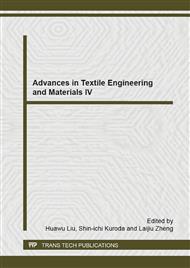p.36
p.41
p.46
p.52
p.57
p.62
p.66
p.72
p.77
Study on the Acid Resistant Properties of Bio-Based Nylon 56 Fiber Compared with the Fiber of Nylon 6 and Nylon 66
Abstract:
The new kind of bio-based nylon 56 fiber has been synthesized by adipic acid and 1,5-pentanediamine, which was prepared by fermenting a variety of starch in straw. The resistance of the nylon 56 fiber to acid need to be studied because the problem of nylon fabrics often encounter reactions of chemical reagents in their processing, finishing and dressing. The factors of acid concentration, temperature and time affect the mechnical behavior of the fibers of nylon 56 ,nylon6 and nylon 66. Strength of all three nylon fibers have obvious decrease if treated in acetic acid concentration of 10 g/L, while have a straight line down if treated in acetic acid concentration of 100 g/L as time increases until to a half falling down at 120 minutes. Bio-based nylon 56 fibers treated in acetic acid concentration of 100 g/L for 30 minutes have a sharp reduction and almost lost its function at 50 minutes.
Info:
Periodical:
Pages:
57-61
Citation:
Online since:
October 2014
Authors:
Keywords:
Price:
Сopyright:
© 2014 Trans Tech Publications Ltd. All Rights Reserved
Share:
Citation:


